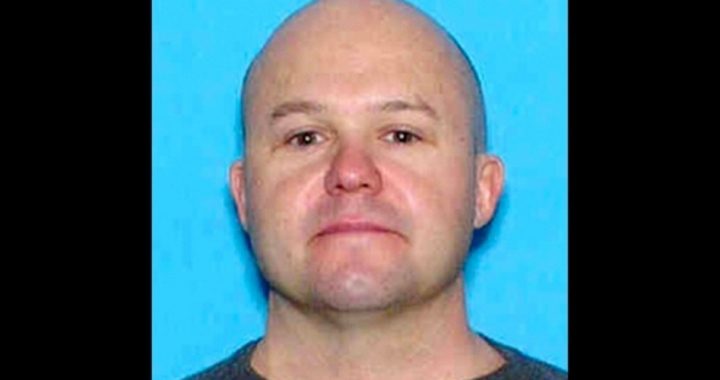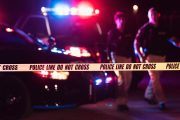
“To a trained terrorist, most airports have the security of a laundromat,” aviation consultant Mike Boyd said, after a SkyWest pilot and murder suspect scaled a fence surrounding St. George Municipal Airport in Utah early Tuesday morning and drove the plane through the wire fence and into the airport parking lot, damaging cars and crashing into the airport terminal. A police officer patrolling the airport found Brian Hedglin (pictured) alone in the cockpit, dead from a gunshot wound to the head in an apparent suicide.
Boyd, chairman of Boyd International Group in Evergreen, Colorado, told CBS News 4 in Denver that while airport security efforts are focused on screening passengers inside the terminal, little attention is paid to guarding the planes outside. “A real terrorist is not going through the screening to try to bust that. A real terrorist is going to do what this guy did — go through the back door,” Boyd said.
Hedglin was wanted in Colorado in connection with the stabbing death of his ex- girlfriend, found dead in her Colorado Springs home last Friday. He had been flying for SkyWest since 2005. The company placed him on administrative leave and deactivated his access cards when it learned he was a murder suspect. A SkyWest spokesperson declined to say whether the plane, a Bombardier CR 1200, was fueled up or whether its doors were locked when Hedglin approached it just before 1 a.m. Tuesday morning, the Associated Press reported.
Airlines have different procedures for securing planes and planes may be manufactured either with or without locking mechanisms, a spokeswoman for Bombardier in Toronto said, while pointing out that it would take someone with training and experience to fly the plane. “An average person wouldn’t be able to walk up and start one up,” Marianella de la Barrera told the AP.
But a trained terrorist might be able fly a plane, loaded with high-explosive fuel, into a building, as terrorists did on 9/11. Then it was passengers on four hijacked planes carried out the terrorist plot that resulted in approximately 3,000 deaths and led to the creation of the Department of Homeland Security and the Transportation Safety Administration. It has also led the TSA, with its much maligned body scanners and pat down measures, to focus on passenger screening to the exclusion of other security considerations, Boyd said.
“The problem is we don’t have airport security, we have airport screening,” he said. “We have pointy object patrol.” U.S. Rep. Mike Rogers (R-Ala.), chairman of the Subcommittee on Transportation Security, said the incident “shows major security weaknesses at our airports that need to be addressed” by the TSA.
“We have been pushing TSA to do a much better job overall of working with its partners, including airport authorities, to improve security,” Rogers said in a statement released Wednesday. “American taxpayers deserve better and have a right to be outraged at this.”
Hedglin used a blanket to cover the razor wire atop the security fence, police said, and was wearing leather gloves when he scaled the fence and made it to the plane unspotted by the lone police officer patrolling the airport grounds during the night. The 40-year-old pilot was wanted by Colorado Springs police for the death of Christina Cornejo, 39. Hedglin dated her for four years and was arrested in March for harassing her, according to the Gazette of Colorado Springs. He was freed on $10,000 bond, the paper said. But his actions inside the plane do not appear consistent with an effort to escape, St. George police said.
“I’ve looked at the crash scene,” Captain James Van Fleet told TV station WSTU (Fox 13) in Salt Lake City. “It doesn’t appear that he goes any other direction. He didn’t make any moves to go towards the runways. He throttled it up and went right towards the parking lot.” Van Fleet said the police were awaiting the conclusions of a toxicology report to determine drug or alcohol use, and for information from the voice and data recorders on the plane. Marc Mortensen, assistant to the St. George city manager, said city officials will be reviewing safety procedures at the airport, but said added security would probably not have prevented Hedglin’s unauthorized entry and his fatal ride.
“I think in these odd circumstances, when someone is hell-bent on doing whatever it is he was trying to do, a number of security measures in place probably wouldn’t have kept this from happening,” Mortensen said in an interview with the Los Angeles Times.
“Incidents like this can happen at virtually any airport, but that’s why you have layered security,” Robert Olislagers, executive director at Denver’s Centennial Airport, told the local CBS affiliate. “There’s always a way to get to the airplane, but there’s not a way to take it or complete a mission.”
But there’s no guarantee that a future criminal or terrorist won’t be a pilot as capable of scaling a fence as Hedglin was, perhaps under different circumstances and with different motives. It is at least debatable whether “pushing TSA” to do more on the taxpayers’ dime, as Rep. Rogers suggests, would be better than prodding the airplane manufacturers and the airlines to take steps to make their own planes more secure. But the incident should be a wakeup call both to the public and to an industry long plagued by security gaps.
“Maybe we need to implement some more levels of perimeter security,” Jeff Price, former assistant security director at Denver International Airport, told the AP, “because any type of security incident like this is a lesson to both the good guys and the bad guys. They read the papers just as much as we do.”
Photo of Brian Hedglin: AP Images



